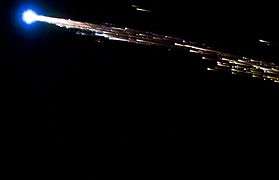Spacecraft cemetery

The so-called Spacecraft Cemetery is an area in the southern Pacific Ocean 3900 km southeast of Wellington, New Zealand,[1] where spacecraft, notably the defunct Mir space station[2] and waste-filled Progress cargo ships[3] are and have been routinely deposited. The area corresponds with the oceanic pole of inaccessibility; the area of ocean furthest from land. It has been chosen for its remoteness, so as not to endanger or harm human life. The nearest land is approximately 1,500 miles away from the cemetery.
Other spacecraft that routinely use the South Pacific re-entry location include several other unmanned resupply spacecraft to the ISS: the Japanese H-II Transfer Vehicle,[4] and the European Space Agency Automated Transfer Vehicle (ATV).[5][6][7] A total of more than 263 spacecraft were disposed of in this area between 1971 and 2016.[8]
Reentry documentation
A particularly well-documented reentry and breakup over the South Pacific was recorded by a large team of NASA and ESA space agency personnel in September 2008, following the first mission of the ESA unmanned resupply spacecraft—the Automated Transfer Vehicle Jules Verne—to the International Space Station (ISS) in March 2008.
On 5 September 2008, Jules Verne un-docked from the ISS and maneuvered to an orbital position 5 kilometres (3.1 mi) below the ISS. It remained in that orbit until the night of 29 September.[9] At 10:00:27 UTC, Jules Verne started its first de-orbit burn of 6 minutes, followed by a second burn of 15 minutes at 12:58:18 UTC. At 13:31 GMT, Jules Verne re-entered the atmosphere at an altitude of 120 kilometres (75 mi), and then completed its destructive re-entry as planned over the following 12 minutes,[10] depositing debris in the South Pacific Ocean southwest of Tahiti.[5] This was recorded with video and still photography at night by two aircraft flying over the South Pacific for purposes of data gathering, with reentry and breakup telemetry data from the craft provided by a Reentry Breakup Recorder and collected by remote communication receivers.
The NASA documentary of the project is in the gallery below.
-

Jules Verne re-enters the Earth's atmosphere southwest of Tahiti.
-
Behind the scenes of the ATV re-entry observation team. NASA, 2008
See also
- Aircraft boneyard
- Atmospheric reentry
- Graveyard orbit
- Pole of inaccessibility
- Space debris
- Wrecking yard
References
- ↑ "NZ spacecraft cemetery gets another skip from orbit". 18 January 2007. Retrieved 2009-02-11.
- ↑ "MIR Space Station is now reentered - March 23, 2001 - 06:45 UTC". 22 March 2001. Retrieved 1 May 2015.
- ↑ "Progress M-18M Mission Updates - Progress ship returns to Earth with trash and no longer needed stuff". 26 July 2013. Retrieved 1 July 2013.
- ↑ John Love (21 September 2012). "Lead Increment Scientist's Highlights For Week of Sept. 10, 2012". NASA. Retrieved 23 September 2012.
- 1 2 "Image of the Day Gallery--October 6, 2008". NASA. Retrieved 2013-05-05.
- ↑ European Space Agency ATV page. Retrieved 21 June 2011.
- ↑ "Mission accomplished for ATV Edoardo Amaldi". Space-Travel.com. 4 October 2012. Retrieved 8 October 2012.
- ↑ Stirone, Shannon (13 June 2016). "This Is Where the International Space Station Will Go to Die". Popular Science. Retrieved 16 June 2016.
- ↑ "'Jules Verne' begins final voyage". BBC. 2008-09-05. Retrieved 2008-09-06.
- ↑ "Successful re-entry marks bright future for ATV". ESA. 2008-09-29. Retrieved 2008-09-29.
Coordinates: 43°34′48″S 142°43′12″W / 43.58000°S 142.72000°W
